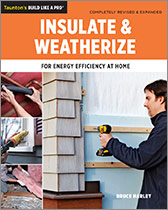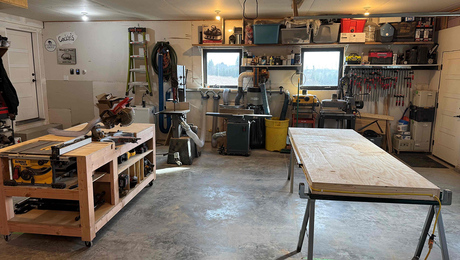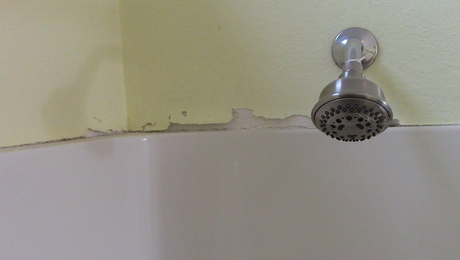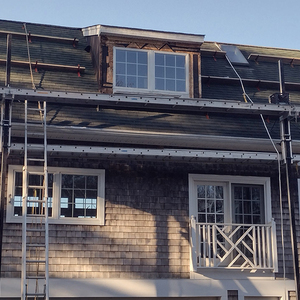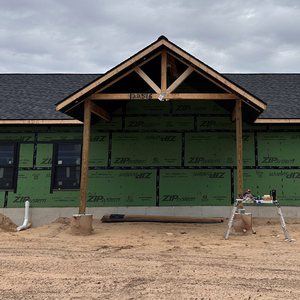Podcast 332: Mossy Roofs, Cold Walls, and Priming PVC Pipe
Matt, Brian, and Patrick hear from listeners about lead dangers and storm windows before taking questions about insulating a brick ranch with board sheathing, supporting a short section of countertop, and cleaning mossy roofs.
Follow the Fine Homebuilding Podcast on your favorite app. Subscribe now and don’t miss an episode:
 |
 |
Help us make better episodes and enter for a chance to win an FHB Podcast T-shirt:
www.finehomebuilding.com/podcastsurvey
Dr. Jason writes in about the dangers of lead. James says storm windows make his house quieter. Nicky talks about HVAC design in New Zealand. Brian from Boise asks for suggestions for warming a cold wall. Eric is hoping for help soundproofing his guest bedroom. Doug asks if you can skip the primer on PVC pipe joints. Patrick asks what he should do about his mossy roof.
Editor Updates:
- Patrick’s mint-green living room painting
- Matt’s painting over ceiling stains
- Brian’s work, work, work
Listener Feedback 1:
A listener writes: As a long-time subscriber I love listening to your show and reading your magazine. Unfortunately, you almost lost me to a heart attack when I listened to the letter about minimizing the importance of lead exposure on show 321. I am a middle-aged Board-Certified pediatrician that is a fellow of the American Academy of Pediatrics that works in Chicagoland. I thought some brief background on lead is warranted. The information that follows can be found from sources like the American Academy of Pediatrics or many departments of public health websites (you for example can search “get the lead out and IDPH” for user friendly information- see link below.)
Even small amounts of lead can harm a child’s brain and nervous system. Lead poisoning can slow a child’s development and cause learning and behavior problems. Pregnant women with lead exposure can also harm the developing fetus. There is no safe lead level! It is correct that very few children have high enough lead poisoning to threaten their life or that is high enough to benefit from chelation therapy. Doctors do not have treatments to reverse the damage that small amounts of lead have on a child. Lead can also get stored in children’s bones and leach back into the blood over very long periods of time long after exposure is gone.
A few fun facts:
- $17-$221 are estimated to be saved for every dollar that is invested in US household to reduce lead exposure
- 535,000 estimated US preschool children have a lead level of > 5 microgram/dl (This level should get managed)
- 23 million estimated total loss of IQ points among US children today due to lead exposure.
- 1 in 5 attention deficit hyperactivity cases are attributed to lead exposure
On an aside note I live in a 100-year-old home and read tons of materials on all aspects of home remodeling/ inspection and building. I am fearless when it comes to any type of project and use them as part of my self-imposed therapy. If you ever want to get the perspective of how a motivated novice would approach some of your listeners’ issues I am happy to participate. My recent projects, mostly during covid, and many inspired by you have included: Bringing my walk-up attic with mechanicals into the building envelope. Gas vented heater in the garage, 100 amp sub panel with new electric for car charging and a still back ordered hot tub, moving all mechanicals for a washer and dryer to have them built in, foe wainscoting over plaster wall, living room electric above a plaster ceiling and fixtures, adding an expansion tank near water heater, replacing the sacrificial anodes in my hot water heaters, replacing about 20 blown glass French door panels and a round window with home milled trim and mail ordered glass, relaying bluestone walkway and replacing broken pieces, installing gas line and installing new 750 lb fire pit with homemade rolling jig that can be used by one person, wall stored fold up mobile 4×8 garage work bench to repurpose wheels purchased for rolling jig, custom car rack for sheet goods, replacing 3 foot corner of house were stucco cracked and many more…
From the above list you can tell I have a patient wife.
I appreciate all that you do,
PPS: don’t use bungee cords
Related Links:
- Lead and Drinking Water: Information for Health Professionals Across the United States(PDF)
- Illinois Department of Public Health: Publications – Lead Education & Training (PDF)
Listener Feedback 2:
A Seattle listener writes: Hi there, On this week’s episode of the podcast, Matt said of storm windows “what, are you going to keep them on all year?”. In my house, we absolutely keep them on all year! We live in a 1912 Craftsman in Seattle near a busy street and the storm windows are a crucial to reducing the amount of street noise that makes it indoors! Even if we didn’t need the storm windows for the sound isolation, insulation is still useful year-round—unless you have seasons where it’s ~70°F outside day and night, you’re still conditioning that space.
Also, I’m glad that the previous owners went with exterior storms instead of interior. In any home, the windows are one of the most influential interior design elements. The interior faces of the windows affect my enjoyment of the home much more since I spend a lot of time looking out my windows and very little time looking in!
Related Links:
Listener Feedback 3:
Nicky from New Zealand writes: Hi Patrick, I’m a 29-year-old guy from Belgium living in NZ for a few years. I’m qualified in metal engineering which I DON’T LIKE. I’ve been listening to the podcast for about 4 months. The last 3 years I’ve become obsessed with passive and energy efficient houses.
In Podcast 267 you asked what is the problem with the HVAC trade? Kiley said you’d get comments, this is one of them.
I have 3 years experience in the HVAC trade in Belgium and one in New Zealand, followed by some HVAC school, and you are guys are right—they only teach us the aircon/heatpump things. My teacher said once if the house is uninsulated don’t sell a heatpump, it’s useless (that’s all he said). If we go to sell a heatpump we look at the window, leaks (how much draft comes through the power outlet, light, etc.).
This will give me an indication how much heat loss we use in the calculation for the size, but that’s all. I try to give my client’s the best advice, but we need to earn money or I will be out of work.
And in 259 you said “Dunedin”; you pronounce it duh-nee-dn. I live in Queenstown and It’s a 3-hour drive over there. It’s a fairly dry climate and houses are sooo leaky, even the new builds.
And it can get bloody hot because of the really aggressive sun. And most of the new builds have small or no overhangs and massive windows…it gets bloody hot inside. Most people just buy a bigger furnace/heatpump instead of making their house airtight.
And btw, electricity is even more expensive than Dunedin…
Keep up the good work!
Love your podcast and all the information you give!
And English isn’t my first language, so don’t look at the mistakes.
Related Links:
- A Beginner’s Guide to HVAC Design
- How to Choose the Right-Size Heating and Cooling System
- Sizing HVAC Equipment
Question 1: What’s the best way to insulate a brick-clad wall with polyethylene sheeting over the sheathing?
Brian from Boise writes: I have an air-sealing and insulation question, but in order to pique your interest I should mention that it does involve brick. My house in Boise, Idaho (a very dry climate-zone 5) was built in 1955 and is a ranch-style with a brick veneer on the East-facing wall (photos and assembly illustrations included). It is by far the coldest of the walls in my house, and I was planning on doing something about it from the interior relative to air-sealing and insulation. My initial idea for an assembly followed the one suggested by Brian Pontolilio’s Walls That Work webinar video, with rigid foam that stood-off from the interior of the sheathing and caulked or taped to the studs for air-sealing, followed by either fiberglass batts or possibly blown-in cellulose. However, in inspecting the existing wall assembly further, I discovered a double-layer of 6-mil polyethylene behind the building paper on the exterior and in direct contact with the board-sheathing. This is where I get confused.
My thinking is that the polyethylene barrier prevents drying to the outside should the sheathing get wet either through vapor drive from the brick or interior, or just general sloppiness in the assembly, which means I need drying potential to the inside, which then means that the rigid foam on the interior is a bad idea. With that in mind, would a Bonfig assembly with mineral wool batts followed by a fully-detailed smart vapor retarder such as Siga’s Majrex on the interior for an air barrier behind the drywall be a better assembly?
 |
 |
 |
Or, am I overthinking the whole thing, and can follow through with the original plan of Mr. Pontolilo’s aforementioned assembly with rigid foam (faced polyiso, for example) followed up with my choice of fluffy insulation?
As much as I’d love a warm wall, I’d prefer a cold one without mold/rot, so if it’s an inherently risky proposition that’d be great to know as well.
Thanks for taking the time to make a podcast every week. It’s carried me through more projects than I can count, and helped to educate and move me from someone who put 5 unsealed can lights in his ceiling just 4 years ago to someone who is willing, albeit begrudgingly, to pay for Swiss-made air sealing products.
Take care, and kind regards from Boise.
PS, I’ve fixed the can lights should anyone ask 🙂
Related Links:
- Crash Course in Control Layers
- An Easy Way To Build a Well-Insulated House
- Six Proven Ways to Build Energy-Smart Walls
Question 2: How can I reduce noice that travels through my HVAC ductwork?
Eric Cole. Adamstown, PA writes, My son’s nursery and our guest room share a common 2×4 stud wall with half inch drywall on both sides. Needless say, sound transfer between the two rooms is an issue. The worst offender is the cold air return in the guest room which is formed by the stud cavity (no ducts) with high and low vents depending on the season. I’d like to cut a 4 ft wide strip in the drywall across the guest room wall and install Rockwool Safe’n’Sound for the majority of the wall. What should I do to reduce noise transfer across the cold air return cavity? Simple, easily to source solutions would be appreciated.
Related Links:
Question 3: Are the new one-step PVC pipe adhesives as reliable as ones that require primer?
Doug Horgan writes, Good morning Podcast. I heard somewhere on the intertubes that code is changing to allow “universal” or one-step glue on PVC drain lines.
I’ve also had conversations in the past where some enterprising plumber was trying to save five minutes by skipping the primer on PVC pipe.
Questions your readers may be interested in: 1) is code changing and 2) if you’re very risk-averse and want a top-quality job, should you stick to using primer anyway? i.e. is it better?
Related Links:
Question 4: Can you suggest a low-profile solution for supporting a countertop?
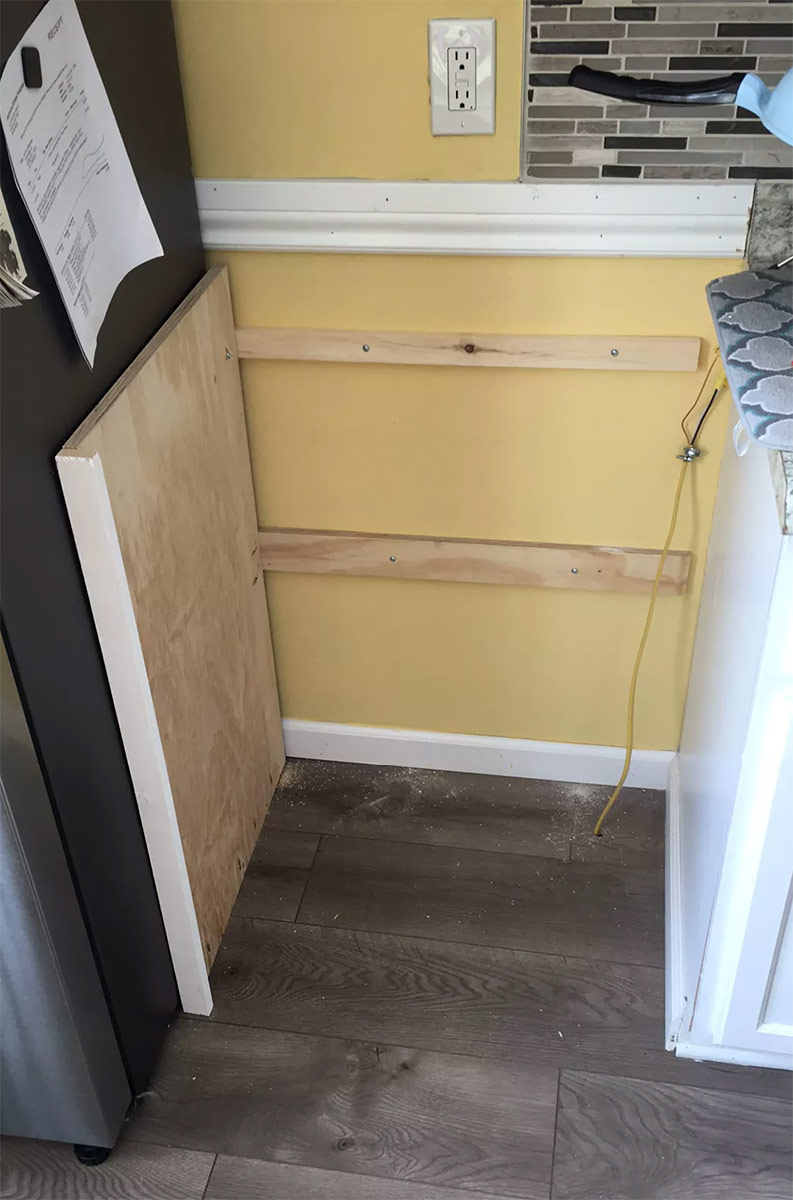
My friend is a new homeowner and has been trying for months to get their dishwasher installed next to their existing cabinets. They finally figured out how to install an end panel themself after no contractors in their area (Buffalo) would take a job that small. They purchased some butcherblock to go over the dishwasher, but are now being told that there is no way to install it without replacing the entire adjacent countertop. You can see in the photo that a new piece of countertop would currently only be supported on one side by the end panel, which is a no-go for obvious reasons. My friend understands this now, but is hoping to figure out a way to support the new piece without replacing what’s already there on the existing cabinets. Is this situation hopeless? I was thinking that they might be able to mirror the end panel next to the existing cabinet so that the new piece is supported like an island, but they are thinking that some kind of L brackets might work, like a floating shelf. As someone who studied structural engineering, I have my doubts about finding a bracket that is up to the task of supporting a heavy, dynamically loaded countertop, especially one small enough to allow a dishwasher to fit underneath. Any ideas, or should my friend resign themself to full countertop replacement?
Not sure that this quite fulfills the “fine” in Fine Homebuilding, but my friend does genuinely care about their home and wants to do their best. If it helps spark some interest, their home also features Yankee gutters, which I used the FHB website to help them look up after their inspection.
Question 5: How can I remove moss from roof shingles, and do I even need to?
Patrick from Sandy Hook writes, What do you all suggest for moss on shingles?
Dyami Plotke responds, The first thing we tell customers who have moss on their roof is to leave it. While it may cause an aesthetic issue, on in the most severe cases, on the worst condition roofs, does it cause a watertight issue. Usually, the cure is worse than the disease.
That said, when customers insist, we recommend copper or zinc strips if they have patience, or a low-pressure power washing with the understanding that is must be sprayed from the top down and may cause damage.
While we’ve never tried Spray and Forget (as customers expect a result before we get paid), it seems like a good product and I suspect it will work.
As for avoiding moss in the first place, new GAF shingles (since they bought ELK a few years ago) are much better than they used to be. Also, I’ve heard wonderful things about the performance of Atlas shingles with Scotchgard (yes from 3M). We’ve only installed a hand full over the years, as most customers have higher priorities than moss, but my distributors swear by the Atlas shingles when Moss is an issue.
On another note, I’m eager to read the recent article on slate. I’m hoping you guys got it right.
Related Links:
Visit the Taunton Store • Magazine Index • Online Archive • Our First Issues • All Access
Help us make better episodes and enter for a chance to win an FHB Podcast T-shirt: www.finehomebuilding.com/podcastsurvey
If you have any questions you would like us to dig into for a future show, shoot an email our way: [email protected].
If we use your question we’ll send you a FHB Podcast sticker!
FHB Podcast T-shirts!
Represent your favorite podcast! Available in several styles and colors. Made from 100% cotton. Find the Podcast t-shirt and more cool products in the Fine Homebuilding Store.
This episode of the Fine Homebuilding podcast is brought to you by BuildBook.
A lot of construction pros have a common problem; your construction management software is either non-existent, or it is too slow and too complex. It shouldn’t be bogged down with complicated features that you have to attend an academy to learn how to use. You need software you can start using DAY ONE without training… That is faster and more reliable than your notepad. That allows you, your team and your clients to always know what’s getting done and when. And your software should reduce stress, not increase it. The solution? BuildBook.
BuildBook is built for today’s modern builder with everything you need, nothing you don’t. Whether you’re a one man operation or a business with a large crew, BuildBook has plans to fit your budget. No nagging sales calls, tricky upsells or hidden fees. Head over to BuildBook.co and sign up for a free 10-day trial — and don’t forget to mention that you heard about them on the Fine Homebuilding podcast.
Visit BuildBook.co for more.
Fine Homebuilding podcast listeners can now get 20% off anything in the Taunton store, including Insulate & Weatherize.
Use the discount code FHBPODCAST to take advantage of this special offer.
We hope you will take advantage of a great offer for our podcast listeners: A special 20% off the discounted rate to subscribe to the Fine Homebuilding print magazine. That link goes to finehomebuilding.com/podoffer.
The show is driven by our listeners, so please subscribe and rate us on iTunes or Google Play, and if you have any questions you would like us to dig into for a future show, shoot an email our way: [email protected]. Also, be sure to follow Fine Homebuilding on Instagram, and “like” us on Facebook. Note that you can watch the show above, or on YouTube at the Fine Homebuilding YouTube Channel.
The Fine Homebuilding Podcast embodies Fine Homebuilding magazine’s commitment to the preservation of craftsmanship and the advancement of home performance in residential construction. The show is an informal but vigorous conversation about the techniques and principles that allow listeners to master their design and building challenges.
Other related links
-
- All FHB podcast show notes: FineHomebuilding.com/podcast.
- #KeepCraftAlive T-shirts and hats support scholarships for building trades students. So order some gear at KeepCraftAlive.org.
- The direct link to the online store is here.





